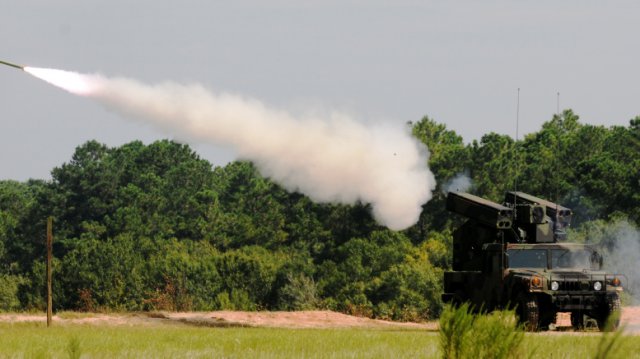
The commander of U.S. Army Europe said that, among other equipment, he wants anti-drone weapons to counter potential threats from Russia.
Lt. Gen. Ben Hodges said he would welcome any number of systems to do the job, from newer non-kinetic technologies to older, Cold War-era equipment such as the Avenger, a Humvee equipped with a launcher housing eight FIM-92 Stinger missiles, as well as the German-made Gepard, a twin-33mm cannon mounted on a Leopard tank.
Hodges said officials at Fort Sill, Oklahoma, are evaluating non-kinetic technologies. While he didn’t specify the name of any new products, Army officials have tested Battelle’s DroneDefender, a shoulder-fired weapon that zaps drones with radio waves and when paired with an Israeli-made radar can detect unmanned aerial vehicles from several kilometers away.
“I know there’s a lot of work being done on non-kinetic means and I am confident that we are going to have some other systems coming down the road … but I need something now,” the general told reporters this month at an Army conference in Washington, D.C. “We didn’t worry about [short-range air defense] over the last several years because there was not a threat,” he said. “Now you look at the UAVs, I need a counter-UAV capability.”
But obtaining and fielding even the older equipment will take some time.
While the Avenger was developed by Boeing Co. in the 1980s and, more recently, deployed around the Pentagon after the Sept. 11, 2001, terrorist attacks and to combat zones during the U.S.-led wars in Iraq and Afghanistan, the hundreds of remaining units are now in the hands in the Army National Guard, Hodges said.
Similarly, the German military developed the Gepard in the 1960s but eventually transferred the units to the Romanian government, Hodges said.
“I’d love to have it,” he said of the air-defense cannon. “Those are some examples where allies have capabilities that are pretty simple but would be effective against a UAV.”
In addition to counter-drone weapons, Hodges said he would like to have more truck-mounted launchers capable of firing MGM-140 Army Tactical Missile Systems, or ATACMS, made by Lockheed Martin Corp.
“Most of the places where we have a shortage are places we used to have lot of things in Europe — lots of bridges, lots of engineers, lots of rocket-launchers — all those kinds of things,” he said. “Decisions were made five, six years ago that were probably the same ones I would have made if I was in those positions based on what we thought and knew at the time. So [we’re] trying to bring those back. There are some shortages in different types of munitions — rockets, ATACMs, things like that.”
Army Materiel Command “and the other services have the same challenge [and] are trying to restart lines because we didn’t think [we] we’re going to need that,” he added. “Now we do.”
Hodges said he may look to the Army’s new Rapid Capabilities Office to acquire the weaponry. The office is envisioned by Army Secretary Eric Fanning as a way to get gear and equipment into the hands of soldiers between one and five years — faster than the current acquisition process.
The Army’s effort to add a bigger 30mm gun to the Stryker armored personnel carrier may also give the service more options in a potential conflict with Russia, Hodges. While an up-gunned Stryker wouldn’t be able to square off against a T-14 or T-72 tank, it could take out a BMP amphibious infantry fighting vehicle, he said.
The Army has a signed a contract with Falls Church, Virginia-based General Dynamics Corp., which teamed with Norway-based Kongsberg, to upgrade a portion of the Stryker fleet with a 30mm weapon as part of the Protector medium-caliber remote weapon station
The service has also entered into research agreements to evaluate CMI’s new Cockerill 3030 turret with interchangeable guns and Raytheon’s sensor called the Commander Independent Viewer, or CIV, on a Stryker, officials said.
Source: Defensetech
